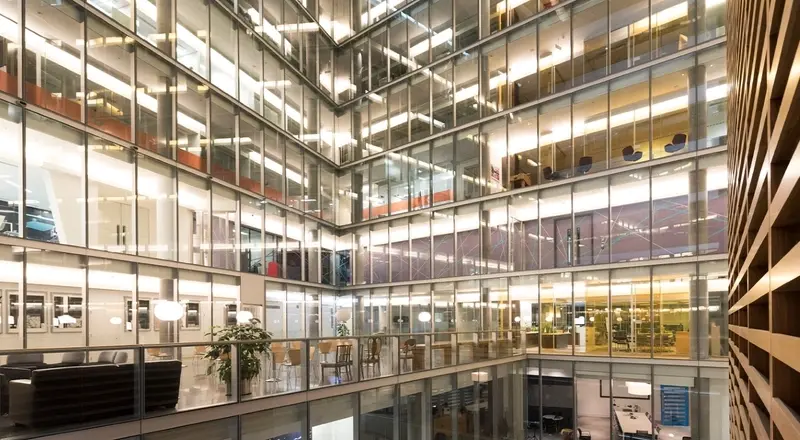
THIS IS AN ADVERTISING FEATURE
UK commercial property has been an unforgiving place to invest in recent years. However, many of the factors that have weighed on the sector are now starting to reverse. There has been a stabilisation of values in key parts of the market and, while caution is still warranted, it could be back to business as usual for the commercial property sector.
The sector has had to make a series of adjustments over the past year. The interest rate environment has been a major tailwind, affecting asset values which led to an adjustment in the net asset values (NAV) for UK commercial property investment trusts. The higher interest rate environment has also deterred investors, leading to a widening of discounts to NAV for most trusts as sentiment has turned.
The sector has also been impacted by a lacklustre economy, and specific problems in certain sectors. The office sector, for example, is facing a structural change as Landlords and Tenants have been forced to adjust to changing work patterns and demands from office users. This has altered the type of properties sought by corporate tenants, generally focussing demand on best-in-class properties with strong amenity and ESG credentials.
A stable landscape
This has been a tough period, but there are real signs of stabilisation for the sector. The consumer price index eased to 6.7% in August. While this is still relatively high, economists had been expecting a rise on the back of higher oil prices. ‘Core’ inflation, which strips out volatile energy and food prices also dropped.
This fall in inflation gave the Bank of England greater flexibility and allowed it to pause on interest rate rises. While the Monetary Policy Committee made it clear that it would remain alert to shifts in economic data, it would now appear that interest rate rises may have peaked. At worst, economists expect another 0.25% increase ahead.
The UK’s economic data supports this view. While the country has avoided a recession, the economic outlook has weakened, making a revival in inflation less likely. The S&P Global UK Services Purchasing Managers' Index (PMI) – a measure of optimism in the UK’s all-important services sector - fell in September to 49.3 from 49.5 in August, below the threshold for growth (50). Employment data has also started to deteriorate. This suggests the impact of interest rate rises is being felt in the real economy and the Bank of England may not have to raise rates further to calm price rises.
This stabilisation in rates means the major adjustment of real estate asset values is now in the past. This revaluation has happened far quicker in this cycle than in others. It may even be possible to look forward to improvements in valuations next year as interest rates start to drop. Either way, it is reasonable to expect sentiment to improve markedly towards UK commercial property from here.
Market dispersion
Nevertheless, this stabilisation is more evident in certain parts of the market than others. The economy is still fragile, and there are still vulnerabilities. These are particularly evident in poorly-located properties, with weak sustainability credentials and an uncertain tenant profile. This is not the time to chase the highest yielding riskier assets in the hope that they will work out.
For example, UKCM has focussed on creating a quality diversified portfolio with almost 60% of its capital allocated to industrial and logistics properties, which present the best opportunity to grow rents and to renew leases. In contrast, we are deliberately underweight to the office sector which continues to show signs of distress. The office assets we do own are regularly subject to rigorous examination to ensure they remain fit-for-purpose. Within the office sector, there is a widening spread of rents between average and high quality stock. It is clear that tenants are willing to pay a premium for good quality, efficient buildings, with low energy consumption and good transport links. Benefits such as cycle to work schemes are playing a crucial role in drawing employees back to offices and buildings are important in facilitating those schemes.
There is also a widening gap between high quality and poorer quality property on vacancy rates. With the best-in-class buildings, vacancy rates drop as low as 2%, but this widens to 10% or more for weaker buildings.
The recovery profile is likely to be different across sectors of the commercial property market. UKCM aims to be positioned in the best quality assets as that recovery emerges. Today, our portfolio holds modern distribution warehouses, most often let to secure long-term tenants and with good growth prospects. We also hold industrial property, such as Ventura Park in Radlett, which is let to a diverse range of high quality businesses. These types of assets can deliver the steady growth in real income and capital that investors used to expect from commercial property.
In spite of some economic uncertainty, most companies have realised they’ve got to carry on, keep occupying property and doing business. If we can continue to provide good quality, affordable space in the right locations we aim to deliver a strong inflation-adjusted income return to our shareholders, plus a measure of capital growth over time. This, as we see it, is business as usual for the UK commercial property sector.
Companies selected for illustrative purposes only to demonstrate the investment management style described herein, and not as an investment recommendation or indication of performance.
Important information
Risk factors you should consider prior to investing:
- The value of investments, and the income from them, can go down as well as up and investors may get back less than the amount invested.
- Past performance is not a guide to future results.
- Investment in the Company may not be appropriate for investors who plan to withdraw their money within 5 years.
- The Company may borrow to finance further investment (gearing). The use of gearing is likely to lead to volatility in the Net Asset Value (NAV) meaning that any movement in the value of the company’s assets will result in a magnified movement in the NAV.
- The Company may accumulate investment positions which represent more than normal trading volumes which may make it difficult to realise investments and may lead to volatility in the market price of the Company’s shares.
- The Company may charge expenses to capital which may erode the capital value of the investment.
- Derivatives may be used, subject to restrictions set out for the Company, in order to manage risk and generate income. The market in derivatives can be volatile and there is a higher than average risk of loss.
- There is no guarantee that the market price of the Company’s shares will fully reflect their underlying Net Asset Value.
- As with all stock exchange investments the value of the Company’s shares purchased will immediately fall by the difference between the buying and selling prices, the bid-offer spread. If trading volumes fall, the bid-offer spread can widen.
Other important information:
Issued by abrdn Fund Managers Limited, registered in England and Wales (740118) at 280 Bishopsgate, London, EC2M 4AG. abrdn Investments Limited, registered in Scotland (No. SC108419), 10 Queen’s Terrace, Aberdeen AB10 1XL. Both companies are authorised and regulated by the Financial Conduct Authority in the UK.
Find out more at www.ukcpreit.com and register for updates here. You can also follow us on social media here: Twitter and LinkedIn.
808055




